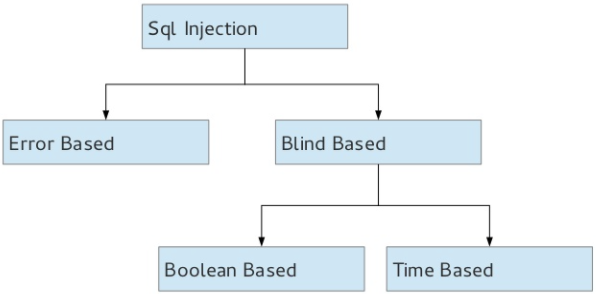Types of SQL Injection

Error based Injection:
The attacker sends some malicious query to the database which results in errors. The errors should be very generic, otherwise, they may give useful hints to the attacker.
Comment-Line: Using comment line to cause the database to ignore a part of a valid query.
E.g. Select * from stores where product_id = blah’ or 1=1-- (everything after this will be neglected)
Tautology: There are a lot of strings which always evaluates to be true, like ‘1’ = ‘1’ ‘a’ = ‘a’, etc., using them in the query to create constantly true conditions.
E.g. Select * from users where username=’blah’ or ‘a’=’a’ -- and password=’pass’
Union Based SQL injection:
Using union command in SQL query to execute additional queries; thereby, modifying/inserting/deleting or dropping the contents of the table.
E.g. Select * from stores where product_id=1 union select 1,database(),user(),4#
Stored procedures: Creating malicious inputs to execute malicious queries.
Incorrect queries: Coming up with logically incorrect queries to see the error messages to get more information about the target database.
Select * from stores where id=1’
The above query will result in a syntax error and might reveal the backend database type.
Blind SQL injection:
This is a type of SQL injection where we don’t have a clue as to whether the web application is vulnerable to injection attack or not.
Types:
Boolean: Only correct queries show the result, wrong queries do not return anything. Attackers should try to generate logically correct queries.

If suppose the original query to the database is
Select * from users where id=’id.txt’
If we give blah’ and 1=1# as input which evaluates to be a right query
Select * from users where id=’blah’ or 1=1#, we will see the user results.
If we give blah’ and 1=2# as input which is a wrong query then we don’t see any results.
Select * from users where id=’blah’ or 1=2#
Time delay: Depending on some conditions, setting a time delay. If that condition is satisfied, we can observe the time delay; thereby, concluding that the input we gave produced a positive result. This is a time consuming process.
Tools:
SQLMAP, Marathon tool.
Perimeter tools (IDS) Evasion Techniques:
-
Use encryption.
-
Obfuscate string to avoid pattern matching.
-
Use Concatenation to confuse the IDS.
-
Use encoding like ASCII encoding, hexadecimal encoding to avoid detection.
-
Insert inline comments between query.